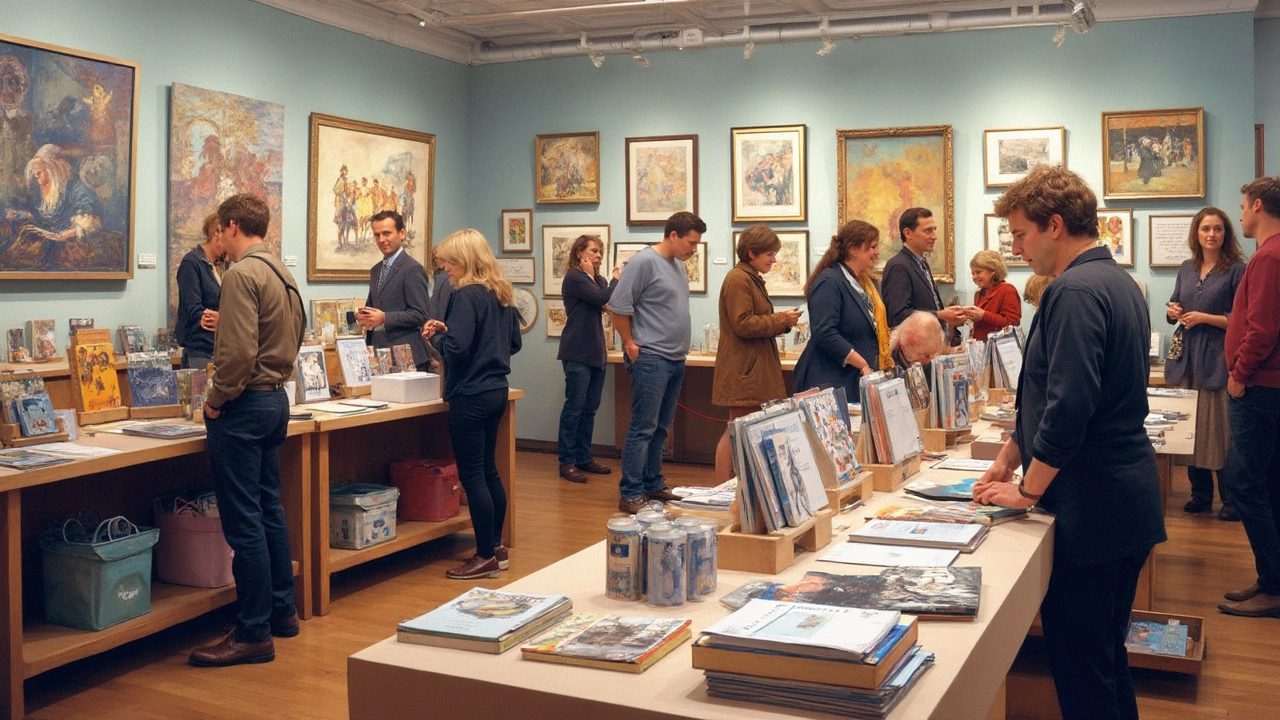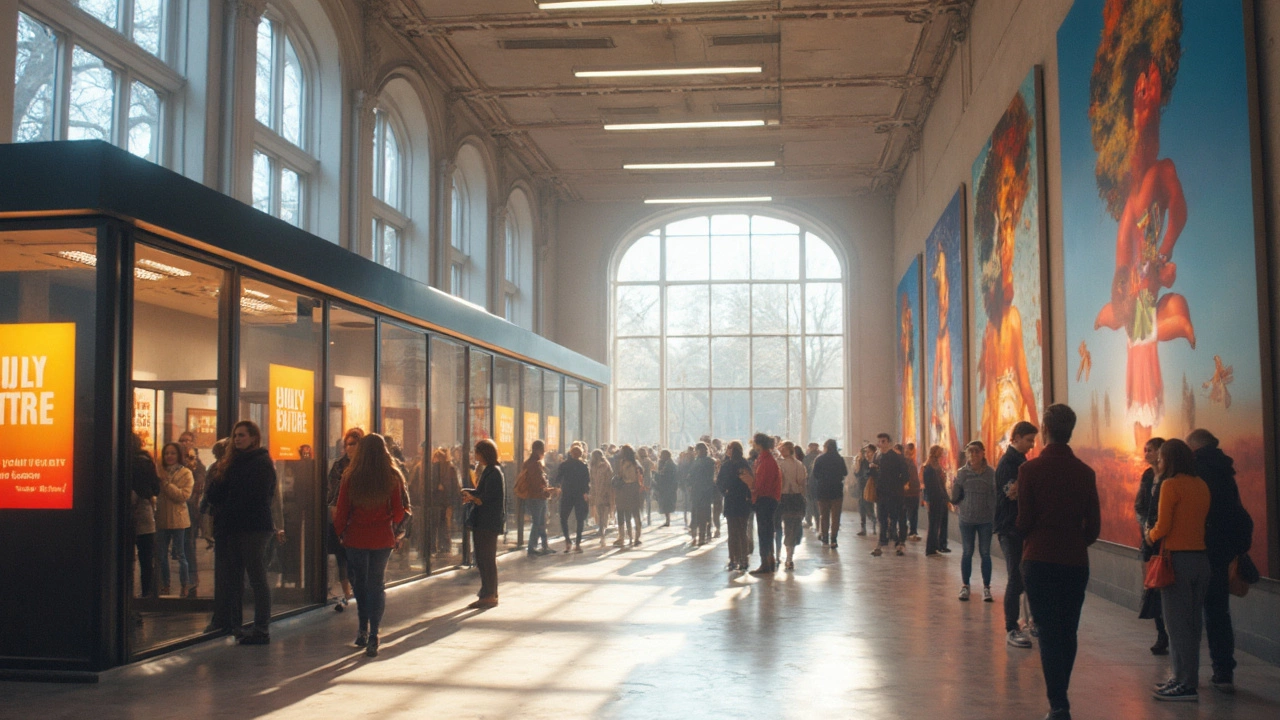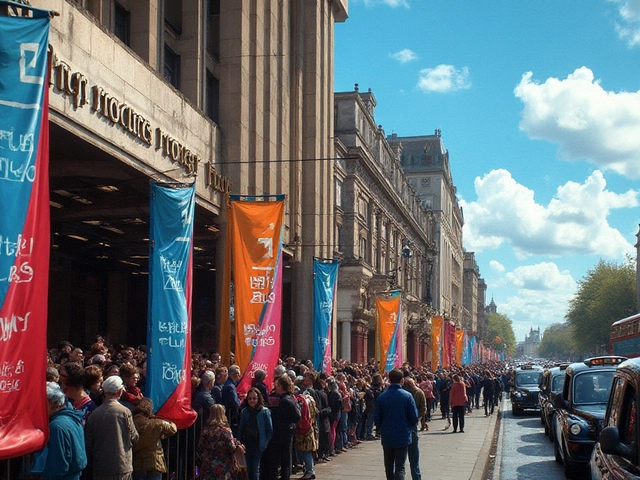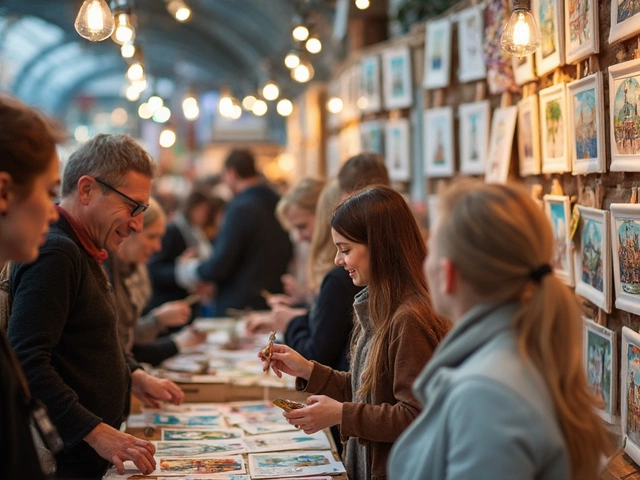Ever wondered how a simple room full of paintings and sculptures transforms into a buzzing cash machine? The art world keeps its cards close to the chest, but there’s big business running beneath those gallery floors. Think glitzy openings, whispered deals, and collectors scribbling checks as fast as artists paint canvases. But of course, it's not just about rich folks buying expensive art. There’s a whole network underpinning the glitter: tickets, cafes, catalogues, sponsors, and a dash of hustle that keeps exhibitions afloat. It’s a world built on emotion and beauty, but make no mistake—every brushstroke pays a bill somewhere.
The Power of Ticket Sales and Entry Fees
Ticket sales are one of the first things you notice at major exhibitions. While many local galleries offer free entry, special exhibits and touring shows almost always charge. The biggest draws, like blockbuster retrospectives or high-profile installations, crank up the price. Think about how the Louvre rakes in over €90 million annually just from ticket sales. Even smaller museums follow suit, especially when they’re hosting a one-off show from a renowned artist.
Most exhibitions use dynamic pricing—meaning, the ticket price can rise as the event gets popular or as dates fill up. Weekend dates, VIP previews, guided tours, and "early access" passes bring in more. For families, there are child's rates, but everything, down to the coat check, adds a little to the bottom line. A fun tip if you’re looking to see a hot show for less: check for "pay what you wish" nights. Exhibitions do this to fill on low-traffic days, but trust me, most folks pay at least the suggested donation.
Ticket revenue isn’t just about making money upfront. It’s a signal to sponsors and collectors that an exhibition has cachet. Galleries brag about visitor numbers to get more corporate partners (and insurance coverage). They’ll show off figures—"Over 50,000 tickets sold!"—to justify more funding for the next show. Some even bundle catalogues or art prints with "premium tickets," which bumps the average amount each visitor spends. So if you ever feel like your wallet’s been emptied after a museum visit, you’re definitely helping keep the lights on for the next big thing.
Art Sales: The Heartbeat of Exhibition Revenue
If you've dreamed about buying a piece of art straight off the wall, this is the part that really matters. For galleries, actual art sales are often the largest revenue source—especially for commercial spaces. The sticker price on some pieces is enough to make your eyes water, but consider that about 50% of the sale usually goes to the artist while the gallery takes the rest. That split can tilt in the gallery’s favor if they handle framing, shipping, or promotion.
Major exhibitions or fairs can move millions in a single weekend. Think of Art Basel Miami Beach, where it’s common for works to be snapped up in minutes—$100 million in total sales is not unheard of for these events. Even at smaller regional exhibitions, galleries rely on foot traffic to convert into sales. The trick? Creating a sense of urgency and exclusivity. Red dots on the wall mean "sold," and suddenly everyone wants what’s already been claimed. It’s psychological, but it works.
What about group shows and themed exhibitions? Here, even if a visitor doesn’t pick up a full-size painting, smaller items—like prints, sculpture maquettes, or sketches—are offered at lower price points. Galleries sometimes run "silent auctions," where works can secure higher bids than sticker prices, especially for charity tie-ins. If you’re hunting for a deal, ask about payment plans many galleries are happy to split the cost over several months. Art sales keep the business breathing, and each sold piece sets the tone for future shows.

Sponsorships, Grants, and Government Help
This is where things get creative. Exhibitions are expensive—think shipping, insurance, artist fees, installation, and security. So where does the cash come from before ticket sales roll in? Corporate sponsors play a huge role. You’ve probably seen big brand logos on banners at museum entrances. Banks, luxury brands, and even tech companies wedge into the art world for the social prestige. Being the "Official Partner" lends a brand cultural credibility.
Sometimes, a single sponsor might cover a sizable chunk of the exhibition cost, but more often, funding is pieced together from multiple sources. These include foundation grants, city or regional arts councils, and sometimes national governments. In 2023, the UK’s Arts Council plowed over £300 million into museums and galleries across the country. That money isn’t just handed out though; proposals have to be airtight, and every expenditure tracked.
Private donors, often board members or local philanthropists, fill in the rest. They might "adopt" a particular artwork or sponsor a gallery room. There’s a bit of ego here—a name on a plaque is a small price for supporting culture (and snagging a tax deduction). If you’re ever at a posh exhibition opening, take note of the speeches. Organizers name-check every backer on the list it’s the silent currency that pays for hors d’oeuvres and keeps the exhibitions running. Behind every great show, there’s a spreadsheet full of grants, donations, and sponsorship deals riding on audience numbers, press, and prestige.
The Hidden Revenue Streams: Gift Shops, Cafés, and Catalogues
Gift shops and cafés might seem like afterthoughts, but they rake it in. Ever bought a mug, tote bag, or fridge magnet featuring a famous painting? That merchandising brings in loads—sometimes more than ticket sales at busy exhibitions. The real moneymakers are exclusive items: exhibition catalogues, artist-signed prints, limited-edition jewelry or apparel, and kids’ art kits. Before shows launch, teams brainstorm every possible item that could carry the theme home.
Food and drink add another level. Some high-end galleries now partner with celebrity chefs or trendy local cafés. There’s a psychological trick at work—people linger longer over lunch or coffee, and are more likely to splurge in the shop after a meal. Together, gift shop and café revenue can chip in 10-30% of an exhibition’s total earnings. Art fair data published in 2022 suggested that the top-earning shop product was a $60 hardcover catalogue for a major sculpture show, followed by quirky artist-designed water bottles.
Catalogues deserve a special shoutout. These beautifully printed books aren't just souvenirs. They look great on a coffee table and boost prestige for both the artist and the exhibition. At a $50 average price, they move in serious volume on opening weeks. Exhibition teams sometimes invite artists to sign books on site, which creates queues and turns the catalogue into a must-have collector’s item. If you’re on a budget but want a piece of the show, catalogues and limited prints can be your gateway into collecting.

Special Events and Side Hustles: Workshops, Rentals, and Digital
There’s more to exhibitions than just watching people stare at paintings. As the art world battles for attention, exhibitions are packing calendars with workshops, artist talks, and "behind-the-scenes" tours. These events almost always demand a separate ticket, even if you’ve already paid to get in. They're popular because they offer a chance to meet artists or curators face-to-face—a big draw for superfans or anyone looking for that extra sprinkle of culture.
Some savvy spaces go beyond, renting rooms for private parties, weddings, or corporate team-building days. That empty event space? It’s really a second income stream. There are even traveling exhibition packages—galleries rent a hit show to museums in other cities or countries. The fee structure here is intricate, with charges based on exhibit size, shipping weight, insurance, and foot traffic potential.
Don’t overlook digital revenue. Ever since the pandemic, virtual exhibitions and digital tours have exploded. Some offer paid online tickets to 3D walkthroughs, or even host livestreamed artist dialogues. A survey in 2024 showed museums making up to 15% of their annual earnings from digital initiatives—sometimes more if the online content goes viral.
| Exhibition Revenue Stream | Average Contribution (%) |
|---|---|
| Ticket Sales | 20-40 |
| Art Sales | 30-50 |
| Sponsorships & Grants | 10-25 |
| Gift Shops & Cafés | 10-30 |
| Special Events & Digital | 5-15 |
Curious which exhibitions make the most? The touring Van Gogh immersive experience made over $250 million worldwide just from ticketed digital shows and pop-up merch. But even local artist collectives can do well by mixing special workshops, art fairs, and clever online engagement. For anyone organizing an exhibition, remember: it’s the creative extras workshops, dinners, surprise installations—that make both visitors and bean counters happy. The best exhibitions aren’t just about showing off art—they’re about building experiences and moving those experiences from the wall to the wallet.





